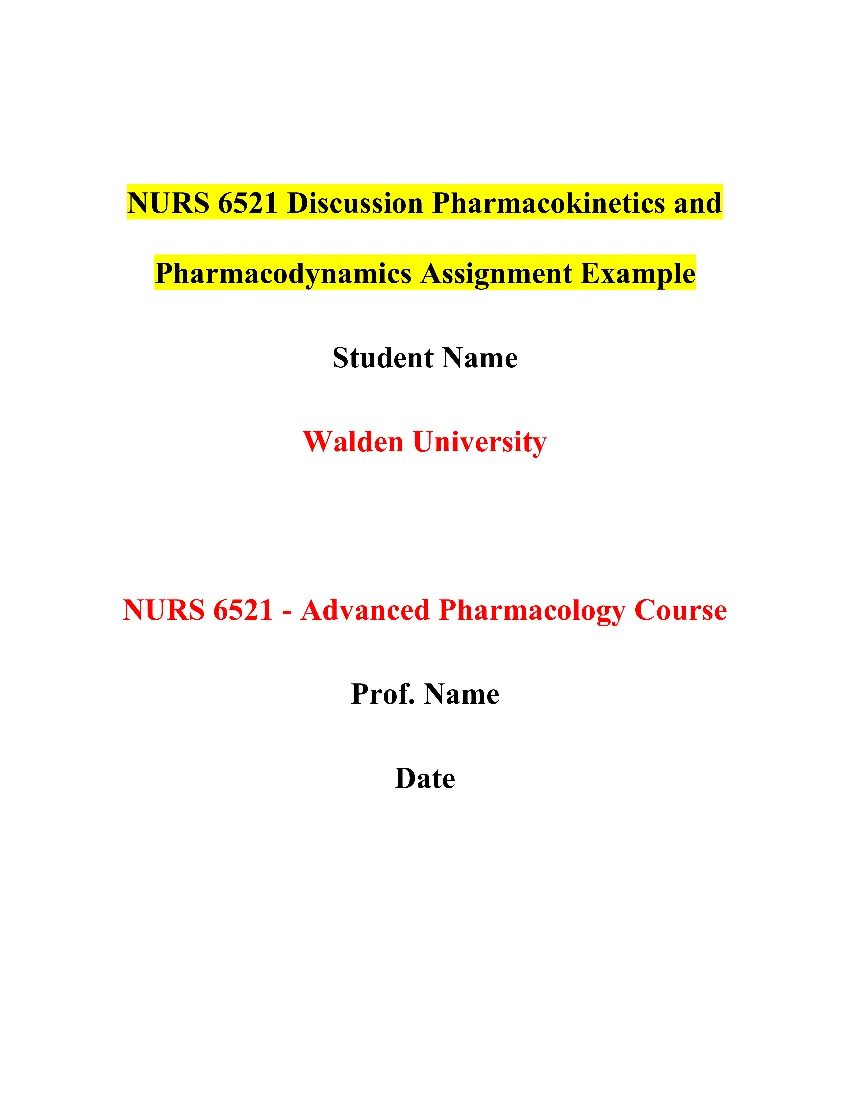NU 607 Concept Map of Praxis Framework Nursing Example
 Assignment Brief: NU 607 Concept Map of Praxis Framework Nursing
Assignment Brief: NU 607 Concept Map of Praxis Framework Nursing
Assignment Title: Framework for Praxis in Sexual Health Education: A Comprehensive Approach
Assignment Objectives:
The primary goal of this assignment is to develop a comprehensive Concept Map of the Praxis Framework in the context of advanced nursing practice, specifically focusing on sexual health education. By synthesizing various elements such as philosophical influences, ethical considerations, theoretical foundations, and a Complex Adaptive System (CAS) perspective, students are expected to create a visual representation that encapsulates the holistic approach required for effective nursing interventions in sexual health education.
Understanding Assignment Objectives:
Phenomenon of Interest (POI) Analysis:
- Identify a relevant Phenomenon of Interest related to sexual health education. Emphasize the significance of the chosen POI in the context of advanced nursing practice.
Philosophical Influences:
- Elaborate on the selected philosophical perspective (Analytic or Continental) and explain its impact on the evaluation of sexual health education programs. Provide detailed insights into the chosen philosophy and its relevance to the assessment of program efficiency.
Ethical Framework:
- Identify and describe the ethical framework guiding decision-making in the advanced nursing practice role. Delve into the ethical principles associated with the framework and illustrate their application in the context of sexual health education.
Theoretical Influences:
- Provide an in-depth description of the Grand Nursing Theory and Middle Range Theory chosen for the Praxis Framework. Explain how these theories guide the understanding and implementation of sexual health education interventions. Explore the CAS related to the POI, emphasizing its significance in addressing the complexities of STI prevalence.
Concept Map of Praxis Framework:
- Construct a detailed Concept Map that visually represents the Praxis Framework. Include elements such as:
- The identified Phenomenon of Interest (POI)
- Analytic or Continental philosophical influences
- Ethical framework and associated principles
- Grand Nursing Theory, Middle Range Theory, and the CAS perspective
- Continuous self-reflection and professional development
- Ensure that the relationships between these elements are visually clear and logically presented.
Integration of References:
- Support your analysis and construction of the Concept Map with a minimum of six peer-reviewed references. Utilize both contemporary sources and classic literature, with a focus on primary literature sources where applicable.
The Student’s Role:
As a student undertaking this assignment, your role is to critically engage with the theoretical, philosophical, and ethical aspects shaping the Praxis Framework for sexual health education. Demonstrate an understanding of how these elements interconnect and contribute to a holistic approach in advanced nursing practice. Use visual representation skills to articulate the complex relationships within the Concept Map, ensuring clarity and coherence. Additionally, employ research skills to integrate relevant and authoritative literature, providing a scholarly foundation for your framework.
Original Assignment Instructions:
Phenomenon of Interest
- Identify the selected Phenomenon of Interest (POI) and briefly describe its importance to your advanced nursing practice specialty focus.
- Provide at least one (1) current peer-reviewed reference
Philosophical Influences
- Describe your preferred philosophical viewpoint (Analytic or Continental) and how it impacts your view of your POI or advanced nursing practice specialty.
- Provide at least two (2) peer-reviewed references. Classic literature may be older than five years.
Ethical Framework
- Identify the ethical framework that will guide decision-making in your advanced practice role and provide a brief description of the chosen ethical framework.
- Identify and briefly describe two (2) ethical principles associated with the chosen ethical framework.
- Provide at least two (2) peer-reviewed references. Classic literature may be older than five years.
Theoretical Influences
- Describe the Grand Nursing Theory and Middle Range theory you selected for your framework and how the theories guide your view of your POI or area of advanced nursing practice specialty.
- Describe a CAS related to your POI or advanced nursing practice specialty,
- Provide at least three (3) peer-reviewed references, citing PRIMARY sources of literature. Classic literature may be older than five years.
This criterion is linked to a Learning Outcome
Concept Map of Praxis Framework
- Briefly describe the Praxis Framework that will guide your future advanced practice role in no more than one paragraph.
- Construct a Concept Map of your Praxis framework and attach it to the initial forum. The graphic representation should Include the following elements:
- The phenomenon of Interest (POI)
- The Concept Analysis you selected with relevance to the POI
- Philosophical influences (viewpoints)
- Theoretical influences (Grand, middle, and complexity theory)
- Ethical framework and principles
Provide citations and references for the selected Concept Analysis article.
NU 607 Concept Map of Praxis Framework Nursing Example
Phenomenon of Interest (POI): Sexual Health Education on Safe Sex Practices
Sexual health education is pivotal for the well-being of individuals, particularly adolescents and young women. This paper focuses on the intricacies of the Phenomenon of Interest (POI): Sexual Health Education on Safe Sex Practices, aiming to address concerns surrounding the effectiveness of existing programs in curbing the prevalence of sexually transmitted infections (STIs). The significance of this study is underscored by the persistently high rates of STIs, notably in regions like Mississippi, which consistently reports elevated infection levels in the United States. The overarching objective is to meticulously assess and enhance sexual health education initiatives, with the ultimate goal of not only reducing STI prevalence but also mitigating the associated healthcare costs. The importance of an elaborate examination of this subject is magnified by the potentially far-reaching impact on public health outcomes and the well-being of individuals, especially in regions grappling with heightened vulnerability to STIs. This paper seeks to provide a comprehensive framework for praxis, integrating philosophical, ethical, and theoretical considerations to guide advanced nursing practice in the realm of sexual health education.
Philosophical Influences
This study adopts an analytical philosophical perspective, emphasizing objectivity and logical analysis in decision-making. Analytic philosophy, as a framework, asserts that complex ideas can be dissected into smaller, more manageable components, facilitating a comprehensive understanding of the subject under examination (de RezendeAlvares & de Sá Freire, 2022). This approach aligns seamlessly with the study’s imperative, as it entails a meticulous evaluation of the efficacy of sexual health education programs in the reduction of STI prevalence. By breaking down intricate concepts into analyzable fragments, analytic philosophy provides a systematic lens through which different programs’ effectiveness can be objectively scrutinized (McVea & Dew, 2021). This emphasis on objectivity becomes particularly pertinent in the context of assessing the diverse landscape of sexual health education initiatives, aiming to distill insights that transcend subjective biases and cultural nuances. The adoption of analytic philosophy in this study thus contributes to a methodical and dispassionate exploration of the multifaceted terrain of sexual health education, adding depth and precision to the overall framework for praxis in advanced nursing practice.
Ethical Framework
In navigating the complex terrain of advanced nursing practice, a robust ethical framework is indispensable. For this study, the ethical foundation guiding decision-making is anchored in the principles of autonomy, beneficence, non-maleficence, and justice. Autonomy, a cornerstone in ethical healthcare practices, demands a profound respect for individuals’ right to make informed decisions concerning their sexual health (Cheraghi et al., 2023). In the context of sexual health education, recognizing and upholding the autonomy of individuals becomes paramount, ensuring that educational interventions respect diverse perspectives, values, and choices.
Beneficence and non-maleficence, intertwined ethical principles, underscore the obligation of healthcare practitioners to act in the best interest of their patients and prevent harm (Nnate, 2021). In the realm of sexual health education, this translates into a commitment to designing and implementing programs that not only disseminate accurate and relevant information but also consider the potential emotional, psychological, and societal impacts on individuals. The delicate nature of sexual health underscores the importance of these principles, guiding healthcare providers to strike a balance between empowering individuals with knowledge and safeguarding their well-being.
Justice, the fourth pillar of the ethical framework, underscores the imperative of equal access to sexual health education and resources (Bjelac et al., 2023). In a world characterized by diverse socio-economic backgrounds, cultural contexts, and healthcare disparities, ensuring justice in the provision of sexual health education becomes central. This ethical principle mandates an examination of potential barriers to access, aiming to develop interventions that bridge gaps and promote inclusivity in educational initiatives.
Theoretical Influences
In establishing the theoretical underpinnings of this study, two distinctive yet complementary nursing theories are selected to guide the framework for praxis in the realm of sexual health education.
The Grand Nursing Theory selected for examination is Imogene King’s General Systems Framework. This theory provides a holistic lens through which to view the complex relationships between individuals and their environments, emphasizing the reciprocal influence of internal and external factors on health-related behaviors and outcomes (Smith, 2019). In the context of sexual health education, the General Systems Framework offers a comprehensive understanding of the intricate web of influences that contribute to the prevalence of sexually transmitted infections (STIs). By recognizing the dynamic interplay between sociocultural norms, individual behaviors, and environmental determinants, this theory facilitates an elaborate approach to designing and implementing interventions that extend beyond surface-level awareness to address the root causes of STI transmission.
Complementing the grand theory, Nola Pender’s Health Promotion Model is employed as the Middle Range Theory for this study. This model, rooted in the understanding of personal and environmental factors influencing health behaviors, provides a practical framework for tailoring interventions to meet the specific needs of individuals (Manjarres-Posada et al., 2020). In the context of sexual health education, the Health Promotion Model guides the development of interventions that go beyond a one-size-fits-all approach. By identifying the unique interplay of individual and environmental factors that shape attitudes and behaviors related to sexual health, this model enables the creation of targeted and culturally sensitive educational materials. In doing so, it ensures that interventions resonate with diverse populations, fostering a more profound and lasting impact.
Furthermore, the concept of a Complex Adaptive System (CAS) is integral to understanding the intricacies of the Phenomenon of Interest (POI). The spread of STIs is not governed by isolated factors but rather through the complex interactions of social norms, individual behaviors, and access to healthcare and education (Vasilenko, 2022). Recognizing the POI as a CAS prompts a strategic approach that addresses the root causes of STI prevalence, acknowledging the interconnectedness of individual behaviors and environmental factors.
In synthesizing these theoretical influences, the study’s framework for praxis in advanced nursing practice is fortified. The General Systems Framework and Health Promotion Model offer a comprehensive and targeted approach to sexual health education, aligning with the intricate dynamics of the CAS related to the POI. This theoretical foundation guides the development of interventions that not only address immediate concerns but also contribute to sustainable improvements in sexual health outcomes.
Complex Adaptive System (CAS) Related to POI
The Complex Adaptive System (CAS) perspective emerges as an indispensable theoretical lens for understanding the intricate dynamics surrounding the Phenomenon of Interest (POI), which is the prevalence of sexually transmitted infections (STIs). Recognizing the POI as a CAS means acknowledging the interconnected and dynamic nature of individual behaviors and environmental factors influencing the spread of STIs (Vasilenko, 2022). This perspective goes beyond a reductionist approach, appreciating that the prevalence of STIs is not governed by isolated factors but arises from the complex interactions of multiple elements within a system.
Within the CAS framework, social norms, individual behaviors, and access to healthcare and education are interlinked and continually evolving. Social norms, shaped by cultural, societal, and community influences, play a pivotal role in dictating sexual behaviors and attitudes toward health practices. Individual behaviors, ranging from sexual practices to healthcare-seeking behaviors, are influenced by a myriad of factors, including personal beliefs, societal expectations, and access to information. Access to healthcare and education, in turn, contributes to the dissemination of information, the adoption of preventive measures, and the overall health literacy of a population.
Understanding the POI through the CAS lens prompts a strategic and holistic approach to addressing the root causes of STI prevalence. Rather than isolating individual components, interventions should be designed to impact the entire system. This might involve community-wide educational campaigns that consider cultural nuances, the promotion of accessible healthcare services, and initiatives to challenge and reshape societal norms surrounding sexual health.
Moreover, the CAS perspective encourages a dynamic and adaptive response to changes within the system. As social norms evolve and individual behaviors shift, interventions should be flexible and responsive, adapting to the ever-changing landscape of factors influencing STI prevalence. This adaptability is crucial for the long-term success and sustainability of interventions, ensuring their continued relevance and effectiveness.
Concept Map of Praxis Framework
The Praxis Framework, serving as the guiding structure for advanced nursing practice in the context of sexual health education, encompasses a comprehensive integration of key elements to ensure a holistic and effective approach.
- Sexual Health Education Effectiveness: At the core of the framework lies the central objective of assessing the effectiveness of sexual health education programs. This involves a meticulous evaluation of various programs, considering their impact on reducing STI prevalence and fostering positive sexual health outcomes. The effectiveness of these programs forms the foundation of the entire framework, driving evidence-based decision-making and tailored interventions.
- Analytic Philosophy: Aligned with the essence of the Praxis Framework is the adoption of an analytic philosophical perspective. This element underscores the need for an objective and logical analysis of diverse sexual health education programs. Analytic philosophy, by breaking down complex concepts into analyzable components, facilitates a rigorous evaluation, ensuring that decisions are grounded in evidence and objective assessment (McVea & Dew, 2021).
- Ethical Principles: The ethical framework, comprising autonomy, beneficence, non-maleficence, and justice, forms a crucial segment of the Praxis Framework. Respect for individuals’ autonomy in decision-making, the commitment to beneficence and non-maleficence, and the pursuit of justice in access to sexual health education resources collectively guide ethically sound decision-making and interventions.
- General Systems Framework and Health Promotion Model: Two overarching nursing theories, Imogene King’s General Systems Framework, and Nola Pender’s Health Promotion Model, provide the theoretical underpinnings for the framework. The General Systems Framework enriches the understanding of the complex relationships between individuals and their environments, emphasizing the need to address internal and external factors influencing health-related behaviors. Meanwhile, the Health Promotion Model guides the development of targeted interventions by identifying the personal and environmental determinants influencing sexual health behaviors.
- Complex Adaptive System (CAS) Perspective: Embracing the CAS perspective within the Praxis Framework recognizes the interconnectedness of individual behaviors and environmental factors influencing STI prevalence. This prompts a strategic approach that addresses the root causes of STI prevalence, acknowledging the dynamic and evolving nature of the system. The CAS perspective ensures that interventions are holistic, adaptive, and responsive to the complex interactions within the sexual health landscape.
- Continuous Self-Reflection and Professional Development: An integral component of the Praxis Framework is the emphasis on continuous self-reflection and professional development. This acknowledges the dynamic nature of healthcare practice and the need for practitioners to engage in ongoing learning and self-assessment. Continuous self-reflection ensures that healthcare providers remain attuned to evolving healthcare landscapes, fostering high-quality care and patient-centered practice.
In the synthesis of these elements, the Concept Map of the Praxis Framework envisions a dynamic and cohesive approach to sexual health education. It not only addresses the immediate concerns of program effectiveness but also considers the ethical, philosophical, and theoretical foundations that underpin informed decision-making and patient-centered care in advanced nursing practice. The interconnectedness of these elements within the concept map reflects the elaborate and holistic nature of the Praxis Framework, ensuring a comprehensive and sustainable impact on sexual health outcomes.
Conclusion
In conclusion, the presented framework for praxis in sexual health education amalgamates diverse philosophical, ethical, and theoretical influences to guide advanced nursing practice. By adopting an analytic philosophical perspective, the framework ensures an objective evaluation of sexual health education programs, vital for evidence-based decision-making. Ethical principles of autonomy, beneficence, non-maleficence, and justice form a moral compass, steering interventions toward patient-centered care and inclusivity. The integration of Imogene King’s General Systems Framework and Nola Pender’s Health Promotion Model offers a comprehensive theoretical foundation, emphasizing the interconnectedness of internal and external factors influencing sexual health behaviors. Embracing a Complex Adaptive System perspective acknowledges the dynamic nature of STI prevalence, prompting holistic interventions addressing root causes. Continuous self-reflection and professional development underscore the dynamic nature of healthcare, ensuring practitioners remain adaptive and committed to high-quality, patient-centered care. This cohesive framework not only addresses the immediate concern of program effectiveness but also fosters a sustained and elaborate impact on sexual health outcomes. The synthesis of these elements within the concept map of the Praxis Framework envisions a dynamic and holistic approach, poised to advance sexual health education and contribute to improved patient outcomes.
Take Your Academic Success to the Next Level with ReliablePapers.com – Your Best Partner in Nursing Papers
Are you grappling with a challenging nursing assignment, staring at a tight deadline, or feeling overwhelmed by complex instructions? Look no further! At ReliablePapers.com, we take pride in being your go-to destination for top-notch nursing paper writing services. Say goodbye to the stress of crafting an essay from scratch; our expert nursing essay writers are here to ensure you not only meet your deadline but also secure the best grades possible.
Why choose us? Our team of professional writers specializes in nursing papers, offering customized solutions for every unique requirement. Whether you need assistance with a nursing phenomenon of interest assignment or seek guidance on a complex nursing topic, we’ve got you covered. Our services are not only reliable but also affordable, ensuring that every college student can access high-quality nursing papers without breaking the bank.
At ReliablePapers.com, we understand the importance of originality. Rest assured, our writers craft each nursing essay from scratch, tailored to your specific instructions and delivered within your deadline. Take a leap toward academic success by entrusting your nursing papers to the experts.
Don’t settle for less; choose the best nursing paper writing service.
Let ReliablePapers.com be your academic ally, saving you time for what matters most. Your success is our priority!
Hire an Expert Paper Writer on Any Subject, Any Topic, Any Deadline! Submit your paper instructions by placing your order here to get started!


 Assignment Brief: Comparative Analysis Paper of the Healthcare System in the United States
Assignment Brief: Comparative Analysis Paper of the Healthcare System in the United States In the world of academic writing, creating an outstanding essay goes beyond just finding good research and making strong points. It’s about using words in a smart and clear way. Imagine it like a puzzle – and the most important piece of that puzzle is grammar.
In the world of academic writing, creating an outstanding essay goes beyond just finding good research and making strong points. It’s about using words in a smart and clear way. Imagine it like a puzzle – and the most important piece of that puzzle is grammar. Assignment Brief: Evidence-Based Practice PICO Question Development for Postpartum
Assignment Brief: Evidence-Based Practice PICO Question Development for Postpartum Homework, at times, may seem like a formidable mountain to climb, but its significance in your educational journey cannot be overstated. However, for those wrestling with the grips of depression, the very idea of approaching assignments can feel like an insurmountable challenge. In such times, understanding how to do homework when depressed becomes not just helpful but crucial.
Homework, at times, may seem like a formidable mountain to climb, but its significance in your educational journey cannot be overstated. However, for those wrestling with the grips of depression, the very idea of approaching assignments can feel like an insurmountable challenge. In such times, understanding how to do homework when depressed becomes not just helpful but crucial.
 NURS 6521 Discussion Pharmacokinetics and Pharmacodynamics Assignment
NURS 6521 Discussion Pharmacokinetics and Pharmacodynamics Assignment
 In the world of academia, deadlines are sacred, and assignments are expected to be submitted on time to avoid the looming specter of academic penalties. Yet, unforeseen circumstances can disrupt even the most carefully planned schedules. Understanding the process of requesting an extension is essential, as it serves as a crucial and sometimes necessary step in managing academic responsibilities.
In the world of academia, deadlines are sacred, and assignments are expected to be submitted on time to avoid the looming specter of academic penalties. Yet, unforeseen circumstances can disrupt even the most carefully planned schedules. Understanding the process of requesting an extension is essential, as it serves as a crucial and sometimes necessary step in managing academic responsibilities. Life often throws unexpected challenges our way, and one of these challenges is looming deadlines coupled with a mountain of homework. But fear not, you’re not alone in this. Many students have navigated similar situations and emerged successful. With the right mindset and approach, you can conquer your tasks even in a limited time.
Life often throws unexpected challenges our way, and one of these challenges is looming deadlines coupled with a mountain of homework. But fear not, you’re not alone in this. Many students have navigated similar situations and emerged successful. With the right mindset and approach, you can conquer your tasks even in a limited time. As students, we all know the struggle of tackling homework. It can be challenging to find the right time and mindset to dive into assignments effectively. Fortunately, the night offers a serene, distraction-free environment that many students find conducive to productivity. In this article, we’ll explore the art of doing homework fast at night, sharing practical tips, effective time management strategies, and motivation techniques to help you excel in your nighttime study sessions.
As students, we all know the struggle of tackling homework. It can be challenging to find the right time and mindset to dive into assignments effectively. Fortunately, the night offers a serene, distraction-free environment that many students find conducive to productivity. In this article, we’ll explore the art of doing homework fast at night, sharing practical tips, effective time management strategies, and motivation techniques to help you excel in your nighttime study sessions.